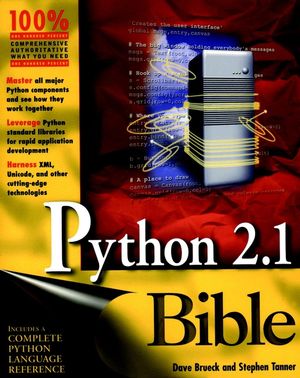Python 2.1 BibleISBN: 978-0-7645-4807-9
Paperback
731 pages
June 2001
 This title is out-of-print and not currently available for purchase from this site.
|
Preface.
Acknowledgments.
PART I: The Python Language.
Chapter 1: Python in an Hour.
Chapter 2: Identifiers, Variables, and Numeric Types.
Chapter 3: Expressions and Strings.
Chapter 4: Advanced Data Types.
Chapter 5: Control Flow.
Chapter 6: Program Organization.
Chapter 7: Object-Oriented Python.
Chapter 8: Input and Output.
PART II: Files, Data Storage, and Operating System Services.
Chapter 9: Processing Strings and Regular Expressions.
Chapter 10: Working with Files and Directories.
Chapter 11: Using Other Operating System Services.
Chapter 12: Storing Data and Objects.
Chapter 13: Accessing Date and Time.
Chapter 14: Using Databases.
PART III: Networking and the Internet.
Chapter 15: Networking.
Chapter 16: Speaking Internet Protocols.
Chapter 17: Handling Internet Data.
Chapter 18: Parsing XML and Other Markup Languages.
PART IV: User Interfaces and Multimedia.
Chapter 19: Tinkering with Tkinter.
Chapter 20: Using Advanced Tkinter Widgets.
Chapter 21: Building User Interfaces with wxPython.
Chapter 22: Using Curses.
Chapter 23: Building Simple Command Interpreters.
Chapter 24: Playing Sound.
PART V: Advanced Python Programming.
Chapter 25: Processing Images.
Chapter 26: Multithreading.
Chapter 27: Debugging, Profiling, and Optimization.
Chapter 28: Security and Encryption.
Chapter 29: Writing Extension Modules.
Chapter 30: Embedding the Python Interpreter.
Chapter 31: Number Crunching.
Chapter 32: Using NumPy.
Chapter 33: Parsing and Interpreting Python Code.
PART VI: Deploying Python Applications.
Chapter 34: Creating Worldwide Applications.
Chapter 35: Customizing Import Behavior.
Chapter 36: Distributing Modules and Applications.
PART VII: Platform-Specific Support.
Chapter 37: Windows.
Chapter 38: UNIX-Compatible Modules.
Appendix A: Online Resources.
Appendix B: Python Development Environments.
Index.
Acknowledgments.
PART I: The Python Language.
Chapter 1: Python in an Hour.
Chapter 2: Identifiers, Variables, and Numeric Types.
Chapter 3: Expressions and Strings.
Chapter 4: Advanced Data Types.
Chapter 5: Control Flow.
Chapter 6: Program Organization.
Chapter 7: Object-Oriented Python.
Chapter 8: Input and Output.
PART II: Files, Data Storage, and Operating System Services.
Chapter 9: Processing Strings and Regular Expressions.
Chapter 10: Working with Files and Directories.
Chapter 11: Using Other Operating System Services.
Chapter 12: Storing Data and Objects.
Chapter 13: Accessing Date and Time.
Chapter 14: Using Databases.
PART III: Networking and the Internet.
Chapter 15: Networking.
Chapter 16: Speaking Internet Protocols.
Chapter 17: Handling Internet Data.
Chapter 18: Parsing XML and Other Markup Languages.
PART IV: User Interfaces and Multimedia.
Chapter 19: Tinkering with Tkinter.
Chapter 20: Using Advanced Tkinter Widgets.
Chapter 21: Building User Interfaces with wxPython.
Chapter 22: Using Curses.
Chapter 23: Building Simple Command Interpreters.
Chapter 24: Playing Sound.
PART V: Advanced Python Programming.
Chapter 25: Processing Images.
Chapter 26: Multithreading.
Chapter 27: Debugging, Profiling, and Optimization.
Chapter 28: Security and Encryption.
Chapter 29: Writing Extension Modules.
Chapter 30: Embedding the Python Interpreter.
Chapter 31: Number Crunching.
Chapter 32: Using NumPy.
Chapter 33: Parsing and Interpreting Python Code.
PART VI: Deploying Python Applications.
Chapter 34: Creating Worldwide Applications.
Chapter 35: Customizing Import Behavior.
Chapter 36: Distributing Modules and Applications.
PART VII: Platform-Specific Support.
Chapter 37: Windows.
Chapter 38: UNIX-Compatible Modules.
Appendix A: Online Resources.
Appendix B: Python Development Environments.
Index.



